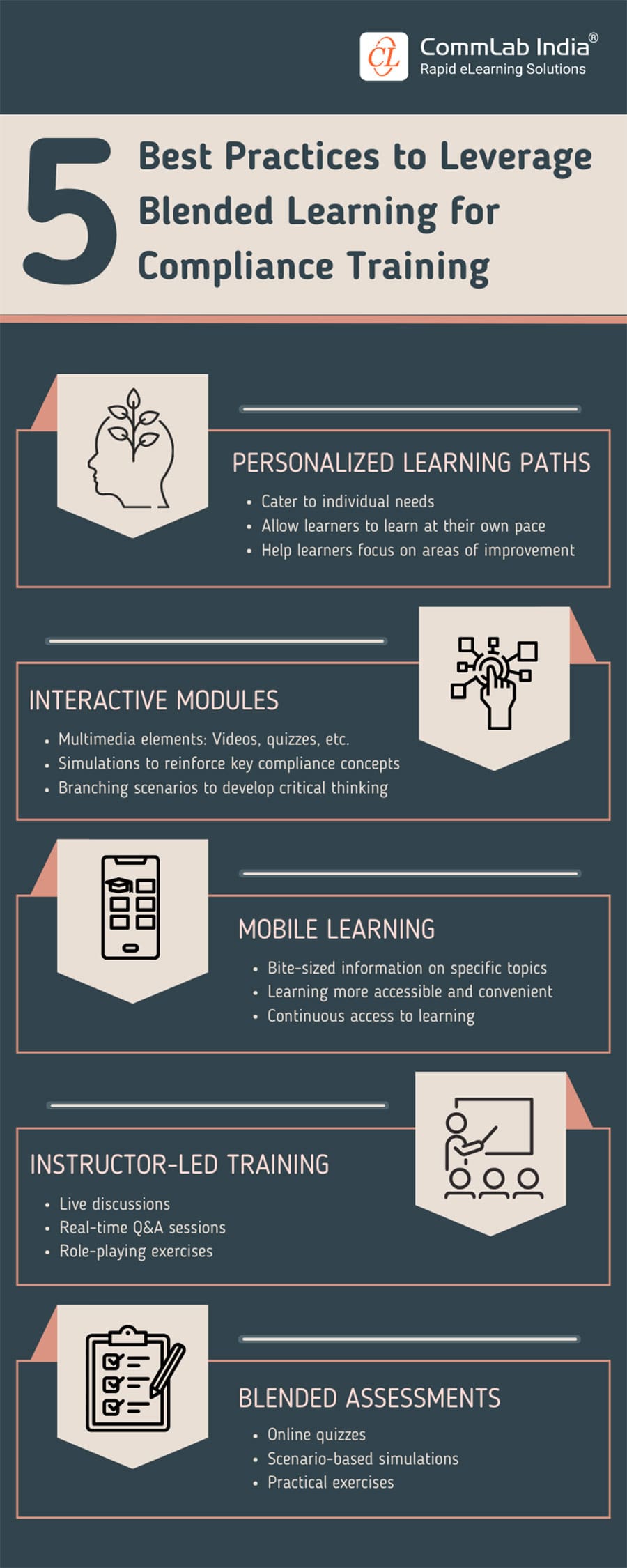5 Best Practices to Leverage Blended Learning for Compliance Training [Infographic]
Ensuring compliance is integral for thriving businesses and blended learning can help. Read on to know the best practices.

In today's complex regulatory environment, ensuring compliance is no longer optional for organizations. From data privacy to workplace safety, adhering to regulations protects your business and your employees. But delivering effective compliance training can be a challenge. Wondering why? Well, it’s because traditional classroom sessions can be monotonous and time-consuming, thereby leading to disengaged learners and ultimately, poor knowledge retention. On the other hand, opting only for eLearning can be tricky as well because there can be certain compliance topics that are more impactful when covered in a face-to-face interaction. In such situations, blended learning saves the day!
Blended learning combines online modules with offline training sessions, facilitating a comprehensive and engaging training experience. Learners can access online content anytime, anywhere, and learn at their own pace, while interactive classroom sessions allow for deeper understanding, clarification, and practical application.
In this blog, we’ll try to understand why ensuring compliance is important in business, how blended learning benefits compliance training and then learn about the best practices of blended learning for compliance training.
Why is Ensuring Compliance Important in Business?
Ensuring compliance in business is critical for several reasons. Here's a breakdown of the key needs:
- Helps avoid legal troubles
- Facilitates risk management
- Ensures ethical conduct
- Builds trust and reputation
- Maintains operational efficiency
→ Download Now: Instructional Design Strategies to Design Engaging eLearning Courses
How Blended Learning Benefits Compliance Training?
Traditional compliance training often faces challenges like low engagement, difficulty retaining information, and inflexibility. To tackle this challenge, blended learning takes center stage. Here's how:
Increases Learner Engagement
Blended learning breaks away from the monotony of lectures by incorporating interactive and multimedia elements in online courses. This keeps learners engaged and fosters a more active learning experience. Along with this, it also provides opportunities for face-to-face interaction that helps build rapport and bonding among learners, thereby fostering learner engagement.
Improves Knowledge Retention
The combination of online modules for foundational knowledge and Instructor-led Training for deeper understanding and clarification leads to better information retention. Learners can revisit online modules for refreshers, solidifying their grasp of key compliance topics.
Enables Accessibility and Flexibility
The online learning aspect of blended learning enables employees to access training modules anytime, anywhere. This sets the stage for the flexibility of self-paced learning and also caters to busy schedules and diverse learning styles.
Supports Targeted Reinforcement
Blended learning allows for targeted reinforcement of specific compliance areas. Trainers can leverage eLearning assessments to identify knowledge gaps, offer additional support and guidance where necessary, and even modify their instructional method for better results.
5 Best Practices to Leverage Blended Learning for Compliance Training
Summing It Up!
In today's ever-changing regulatory landscape, ensuring that your workforce stays compliant is the key to successful navigation toward success. Blended learning offers a powerful solution, injecting engagement and flexibility into traditionally dry training. By incorporating online modules, interactive activities, and Instructor-led Training, you can empower your employees to retain knowledge, apply it practically, and contribute to a culture of compliance within your organization. So, ditch the outdated methods and embrace blended learning. It's time to make compliance training not just informative, but truly transformative. To add transformation and wow factor to your training courses, there are instructional design strategies that you shouldn’t miss. Check them in the eBook below!






